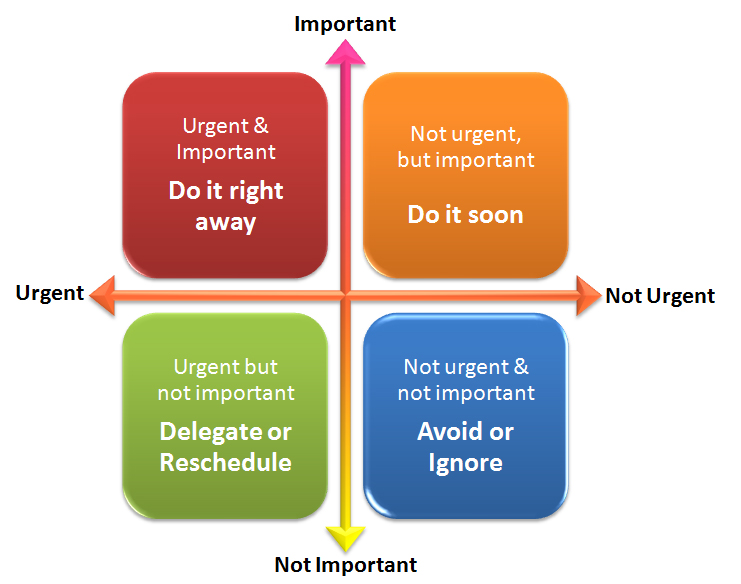We have been there before: an extensive to-do list, and every tasks on it seems right and somehow demands your attention. So what’s the next logical step for you? Do you procrastinate? Or run away from it? Or is paralysed by the sheer amount of things to do? Are you overwhelmed with so many things and tasks to do, yet you never seemed to get on to finishing them? Instead, they get to you first. Critical deadlines begin to slip, things you really need to do seemed to float into oblivion, your customers’ complains ensue, and soon, you find your patience running too short, and the blackened face of your stakeholders growing too long.
You are not alone in this struggle; we all do fight this challenge from time to time when the tsunami of tasks attack your life. The key here is to get to the heart of these tasks, and start classify them into the four categories below. You may find this technique too “common-sense”, but often times, the problem is this: we do not make it a concious effort to classify our tasks.
Important or Urgent?
Let take a look at the two important definitions. First, what is an important task? These are activities that have an outcome that leads to you achieving your goals. Hence, you need to set goals first, else you wouldn’t know if a task is really important or not. Make sense? Good 🙂 Next, what is an urgent task? These are activities that demand immediate attention. Often, it has something to do with others achieving their goal by your doing these tasks.
Therefore, simple maths means the permutation these two definitions results in 4 classifications: Urgent & Important, Urgent but not important, Not urgent but important, and lastly not urgent and not important.
So, what are examples of these 4 classifications?
Urgent and Important (Do it right away): e.g. Your mum fell in the bathroom, and sustained a cracked hip bone; a last-minute customer meeting that could give your company a new $5-million deal.
Not Urgent, but Important (Do it soon): e.g. Your project will start next 2 week, and the project plan is still undone. Many people rely on it for planning their work going forward.
Urgent, but Not Important (Delegate or Reschedule): e.g. Your shopping voucher will expire in 2 days time. But you have no time to redeem it. Send someone to buy an item on your behalf and use the voucher.
Not Urgent, Not Important (Avoid or Ignore): e.g. Your colleagues are calling you out for a night’s drinks in the last few weeks, but you have your family to take care of and several projects on hand to complete. Say “No” politely- complete the important + urgent & important + not urgent tasks first.
The Priority Grid
This Priority Grid as some of us call it, is a powerful method of thinking about your priorities. Using this grid helps you overcome your natural tendency to focus on the urgent (and perhaps unimportant) activities, so that you can keep clear enough time to focus on what’s really important and key to your success. Hence you will stay clear of the fire-fighting situation, into a desirable state, where you can stay focused and look at growing your capacity/capabilities and your career.






[…] As with all things in life, there is a need to prioritise. Prioritising provides a means for you to focus on what is most important to you. Do not let what is not important rob your time from what matters most. You cannot help everyone, you cannot do everything. So, practice priorities. Ask yourself – will this matter 1 week down the road? Does it affect you even if you don’t handle it? Are there grave consequences if they are not tackled soon? There are two types of issues that you can quickly review- (a) things that will happen but will not or minimally impact your life (important part of life, that is); or (b) things that will happen/has happened anyway and you cannot do anything about it (i.e. out of your control). For (a), ignore them. For (b), manage it. For the rest, you can practice the Priority Grid outlined here in my previous post. […]